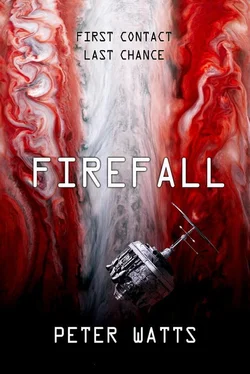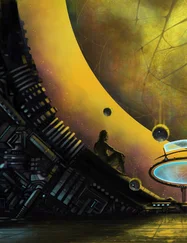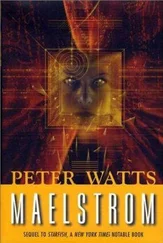The only way out was up. He took a breath and raised his foot.
The ladder left him at the bottom of the spoke, on a circular ledge framing the hatch. Another ladder opposite stretched up into the distance like an exercise in perspective geometry. He had not been hallucinating before: its rungs were easily a meter apart, unclimbable in Earth gravity. An easy enough reach here, though, under half that pull.
Not that it mattered. The ladder was only a fallback. The conveyor belt descended smoothly into its burrow to his left, passed around some hidden wheel beneath his feet, rose again toward the Hub. Its stirrup-handholds swept past at two-meter intervals, thoughtfully spaced for a foot and a hand. Going up; going down.
Going up.
Even under power the ascent seemed light-years long, an infinite regression of rungs and rings and bulkheads that almost seemed to breathe when he wasn’t looking. The belt drew him up through a series of telescoping segments; hazard striping highlighted the spots where each handed off to the next, where the bore of the tunnel increased by some fractional increment. Little readouts, logarithmically spaced along the bulkhead, pegged the gravity—0.3, 0.25, 0.2—as he rose.
Halfway up, the panic returned.
He had a few seconds’ warning: a sudden formless disquiet spreading through the gut, an anxiety that his civilized neocortex tried to write off as simple acrophobia. In the next instant it metastasized into a bone-chilling terror that froze him solid. Suddenly his breathing was fast as a hummingbird’s heartbeat; suddenly his fingers were clenched tight as old roots around a rock.
He waited, paralyzed, for some nameless horror to rise in his sight and tear him limb from limb. Nothing did. He forced himself to move. His head turned like a rusted valve, creaked left, right; his eyes rolled frantically in search of threats.
Nothing. An intersegmental gasket passed around him. The rungs of the ladder ticked unremarkably by. Something flickered at the corner of—but no. Nothing there.
Nothing at all.
Over endless seconds time resumed its normal flow; the panic slouched back to the bottom of his brain. Brüks looked back down the way he’d come. His stomach stirred uneasily, but he saw nothing to provoke the slightest unease.
Down had disappeared by the time he reached top; Coriolis, pulling him gently sideways, persisted a few moments longer. He emerged near the bottom of the southern hemisphere, from one of the six teardrop protuberances ringing the south pole. The tunnel he’d glimpsed there before was sealed now, a waist-high railing around its perimeter, a great foil hatch squeezed tight as a sphincter across its mouth. An iris with no pupil. Its fish-eye reflection turned the mirrorball opposite into a blind chrome eyeball.
He turned to face the grille bisecting the Hub: the rings of some mercurial Saturn, closed in a tight hug. Fragments, flickers of motion were visible through that rotating mesh ( stationary mesh, he corrected himself; it was this lower hemisphere that turned): the bottoms of bare feet, a flash of yellow rendered in a fractured mosaic. An insect’s-eye view.
Soft voices filtered back through the grille. The yellow fragments moved like a school of fish. “Come on up.”
Moore’s voice.
There were two routes forward, two circular openings in the grate on opposite sides of the mirrorball. One was blocked by a retracted spiral staircase squashed almost flat, a black metal pie chart cut into staggered slices: a vital thoroughfare when the engines burned, when acceleration turned forward into up . A useless bit of lawn sculpture now, pulled up and out of the way.
The other was clear, though. Brüks kicked off from the bulkhead, sailed through the air with a mix of exhilaration and mild terror, flailed as the opening drifted lazily past and left him grabbing at the grille a couple of meters antispinward. Chastened, he clambered sideways and through like a crab emerging from its burrow, floated into the northern hemisphere between mirrored earth and smart-painted sky.
Moore stood barefoot, toes curled into the grating, attention focused on a tacband wrapped around his forearm. Mimetic G-couches disfigured the northern half of the mirrorball like body-cast impressions pressed into cookie dough. They ranged radially around the temperate zone, their headrests converging toward the pole. Anyone installed in one of those couches would find themselves looking forward onto the Hub’s northern hemisphere: the dome of an indoor sky, a featureless wash of smart paint save for one spot where yet another redundant ladder stretched from the grille to a hatch just to one side of the north pole.
A Hindian woman strapped into the mirrorball—late twenties perhaps, blunt dark bangs, nape shaved halfway to the crest of her skull—jerked her head away the moment Brüks tried to meet her eyes. Something seemed to catch her attention down by her right foot. “About fucking time.” She wore a chromaform vest over her orange jumpsuit ( We’re color-coded, Brüks realized): infinitely programmable, but all it showed now was a translucent render of the very couch she was strapped into. It turned her into a pair of arms and a floating head grafted to a ghostly body.
Lianna hovered off the grille on the far side of the compartment. She flashed a smile that broadcast welcome and apology in equal measure. “Dan Brüks, Rakshi Sengupta.”
Brüks took another look around the dome; “Uh, Valerie…”
“Won’t be joining us,” Lianna said.
“Fixing her arm, ” Sengupta added.
Thank Christ .
“So,” Moore began, clearly eager to cut to the chase now that the straggler had arrived. “What was it?”
Sengupta rolled her eyes. “Whaddya think they burned through the felching spoke it was an attack .”
Who, Brüks wondered, and held his tongue.
“I was hoping for a bit more detail,” Moore said mildly, unfazed.
Lianna obliged. “Basically they turned a magnifying glass on us. Focused microwave pulse, about half a gigawatt judging by the damage.”
“From where?” Moore asked.
Lianna bit her lip. “Sun. Northern hemisphere.”
“That’s it?”
“Even Bicams have limits, Jim. It’s pure hindsight; differential heat stress on different facets of the structure, spoke trajectory—basically they just back-calced how the different parts were lined up at the time, figured a bearing from the angle of the hit.”
“Coulda done that ourselves,” Sengupta grumbled.
“ Who? ” Brüks blurted out. “Who hit us?”
Nobody spoke. Sengupta regarded something in his general direction the way she might examine a bit of fecal matter scraped off her boot.
“That’s what we’re trying to figure out,” Lianna said after a moment.
Moore pursed his lips. “So the hive didn’t see it coming.”
She shook her head, as if reluctant to admit to the shortcoming out loud.
“Tran, then.”
“It’d be one for the books if a baseline caught them with their pants down.”
Moore’s eyes flickered to stern. “Under normal circumstances, certainly. They’re not exactly operating at a hundred percent.”
Gray icons, clustered in the Hold. “Uh—” Brüks cleared his throat. “What are they doing back there, exactly?”
“Convalescing,” Lianna said. “Bug hit them a lot harder than it hit us. We’ve pumped up the pressure to speed their recovery, but it’ll still be days.”
“So after the break,” Moore mused.
Break?
Lianna nodded. “We’ll have to boot up at least a week early on the other end. They want the option of going hands-on.”
Читать дальше








